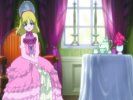Eye For Film >> Movies >> Le Portrait De Petit Cossette (2004) Film Review
In the first of the three episodes that make up Akiyuki Shinbo's anime series Cossette No Shôzô, or Le Portrait De Petit Cossette, epicene hero Eiri Kurahashi is seen walking through an underpass that is conspicuously graffitied with the English words "Gothic + Lolita". In its Japanese context, this might be taken as a reference to the GothLoli fashion subculture, where teenage girls dress up to resemble porcelain dolls from the 19th century - and sure enough, the show's titular child heroine Cossette d'Auvergne sports a full range of elaborately layered costumes (and dolls) from centuries ago.
Shinbo's series, adapted by Mayori Sekijima from the manga by Asuka Katsura, takes the terms Gothic and Lolita right back to their roots, combining the pedophiliac preoccupations of Nabokov's notorious 1955 novel with the darker elements from Victorian literature, such as Dracula, Alice In Wonderland and (most of all) The Picture Of Dorian Gray. The result is a creepy riff on beauty, love, the madness of artists and the treachery of images.

While looking after his uncle's antiques shop, Eiri discovers a Venetian drinking glass whose iridescent facets have trapped the ghostly image of a little blonde girl named Cossette, one-time fiancée to Italian portrait artist Marcelo Orlando. Eiri becomes obsessed with finding out what happened to the girl, why she looks so sad, and why only he can see her. Already deeply in love, he agrees to endure excruciating agonies to help her escape her 250-year-old confinement, even as his behavior grows ever more dangerous and disturbed.
Le Portrait De Petit Cossette blurs the boundaries between youth and age, sanity and delusion, decadence and mortality, reality and representation - and also between the genders, if indeed there is no misprint in the film's original alternative French title. Western distributors have quietly “corrected” the title's masculine “petit” to a feminine “petite,” but when the passive male protagonist Eiri is voiced by a woman (Mitsuke Saiga) and when Cossette herself may be no more than a fantasy figure reflecting Eiri's own artistic (and erotic) imagination, it is anyone's guess how the young temptress ought really to be sexed. In any case, the film follows a long tradition of S&M art by confining itself to eroticism and fetishism rather than full on hentai-style copulation, and despite scenes of brutal murder and demonic torture, the film is imbued with a tone of surprising innocence.
As the story slides from mystery to romance to horror and back again, before forcing viewers to do a triple-take at its mind-bending (and highly reflexive) conclusion, it is equally disorienting in its visual style, where the distorting reflections of crystal, stained glass, mirrors, viewfinders and sunglasses ensure that nearly every image in the film is seen through a glass darkly. More conventional animation often gives way to a beautiful pastel effect that might be described, appropriately enough, as “painterly”, while light and shadow are given every opportunity to come out and play.
It is just as well, however, that there is so much arresting eye candy on offer, for despite its relative brevity, the series is hardly a model of economic, or even compelling, storytelling. The first episode sets everything up nicely enough and the final episode features some neat twists in its tail, but the second has, at least as far as I could tell, no point to it at all, apart from revealing the identity of Cossette's killer, something which even the most mildly perceptive of viewers will already have worked out for themselves. Amidst the definite lull in proceedings that this middle episode represents, you may find yourself unnecessarily distracted by the film's conspicuous paucity of solid characterisation, or by certain blind spots in the script. For example, how come Eiri has so much free time on his hands (all jokes about the laziness of students aside)? And why does almost every woman with whom Eiri is acquainted have psychic powers?
Still, logic and realism are the last things that should be sought in this hallucinatory Gothic ghost story for the aesthetically inclined. So turn on, tune in, drop out and prepare yourself for a richly textured treat.
Reviewed on: 27 Jan 2007



















